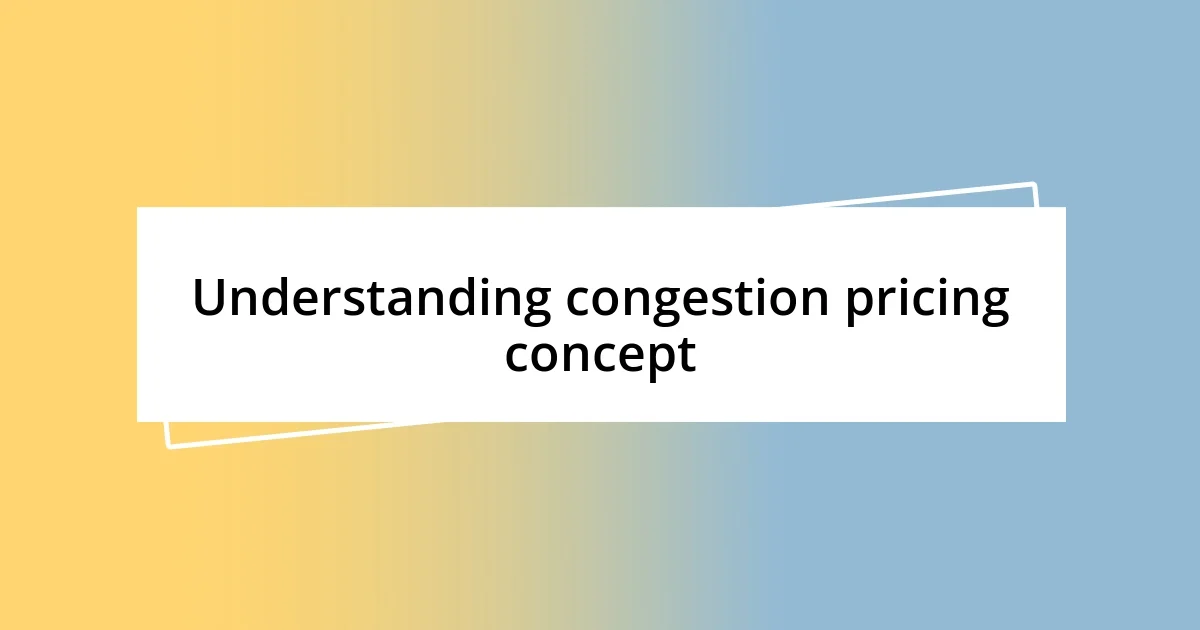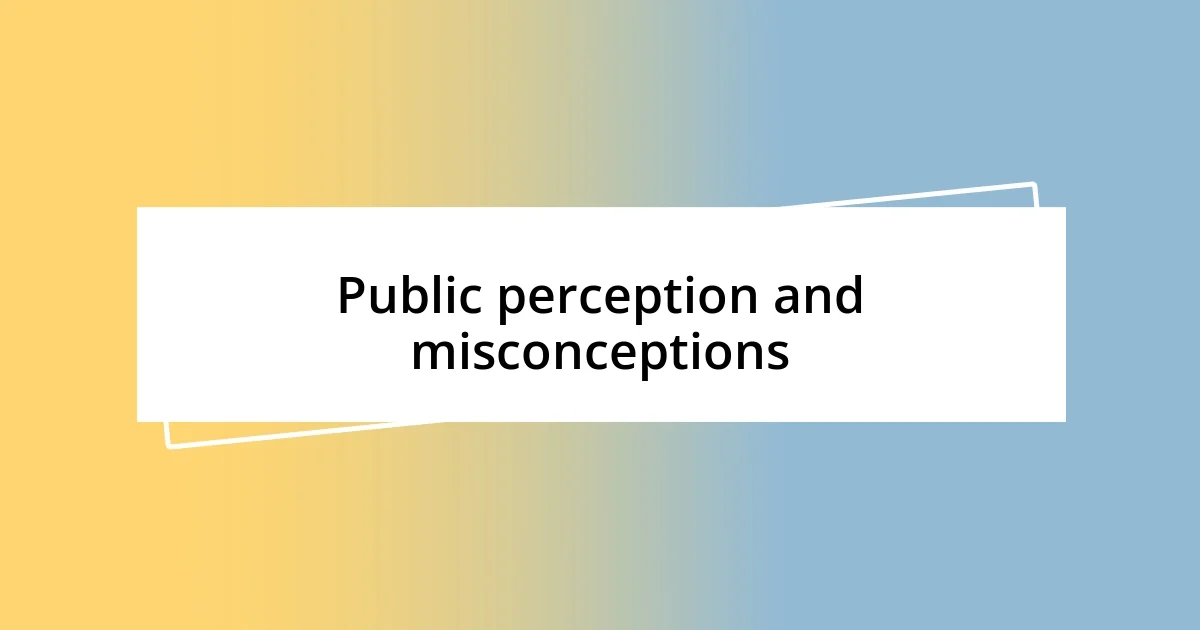Key takeaways:
- Congestion pricing reduces traffic by charging fees for driving in busy areas during peak hours, encouraging public transport and alternative commuting methods.
- Successful implementations in cities like Singapore, London, and Stockholm demonstrate significant decreases in congestion and improvements in air quality and public transport usage.
- Challenges include public resistance due to perceived financial burdens, concerns about equity for lower-income individuals, and skepticism regarding the effective use of generated revenue.

Understanding congestion pricing concept
Congestion pricing is a fascinating concept designed to tackle traffic jams by charging drivers a fee to enter the busiest areas during peak hours. I remember the first time I drove through a city that had implemented this system; I was initially skeptical about the additional costs, but over time, I noticed fewer cars on the road and a more pleasant driving experience. Doesn’t it make you wonder how our daily commutes could change if we adopted such strategies more widely?
In essence, the idea is simple: by making drivers think twice about when and where they travel, cities aim to reduce congestion and promote the use of public transport. I recall chatting with a friend who lives in a congested urban area, and he mentioned how congestion pricing prompted him to explore biking to work instead. It’s interesting to see how financial incentives can shift our behavior and, in turn, benefit the larger community.
Moreover, congestion pricing has the potential to generate revenue that can be funneled back into public transportation, further enhancing the overall infrastructure. This cycles back to the quality of life; imagine cleaner air and less noise. Have you ever thought about what our cities could look like if we prioritized efficient mobility? The benefits could be transformative!

History of congestion pricing implementation
The concept of congestion pricing has a rich history, tracing back to pioneering efforts in the 1960s. One of the earliest examples was in Singapore, where they introduced a road pricing system in 1975 to reduce traffic in the central business district. I often think about how bold that move was; it required a significant cultural shift to get people on board with paying to drive in busy areas.
Here are some notable milestones in the evolution of congestion pricing:
- 1960s: The idea emerged as urban centers grappled with increasing traffic congestion.
- 1975: Singapore implemented the world’s first electronic road pricing system.
- 1981: Stockholm introduced its first trial tolls to manage congestion.
- 2003: London launched its Congestion Charge, significantly impacting traffic levels in the city.
- 2010: New York City proposed a congestion pricing plan to manage Manhattan traffic.
Reflecting on these developments, I can’t help but admire the courage it takes for cities to embrace such innovative strategies. My friend who travels frequently always remarks on how congestion pricing seems to create a shared understanding among drivers: we’re all in this together, trying to make our city livable for everyone. It’s a compelling reminder that change often starts with a single decision that leads to broader, transformative outcomes.

Benefits of congestion pricing models
Congestion pricing models offer numerous benefits, starting with the tangible reduction of traffic congestion. I’ve found that when cities implement these pricing strategies, the streets become less crowded and more navigable. Imagine driving home after a long workday and noticing how much smoother the commute is—that’s often the reality in areas with congestion pricing. It can feel like a breath of fresh air, can’t it?
Another compelling advantage is the environmental impact. With fewer cars on the road, emissions decrease significantly. I remember walking through a downtown area where congestion pricing had been adopted; the air felt cleaner, which made my time there much more enjoyable. It’s amazing how something as simple as altering driving behavior can lead to widespread environmental benefits. Have you ever felt the difference in air quality when you’re in a less congested area?
On a larger scale, the revenue generated from congestion pricing can be reinvested into public transportation. This development can enhance accessibility and encourage more people to consider alternatives to driving. I recently spoke to a commuter who frequents a city benefiting from such initiatives; they shared how improved public transit options made a significant impact on their daily life. By funding better transit, congestion pricing can create a ripple effect that elevates the quality of urban living.
| Benefit | Description |
|---|---|
| Reduced Traffic Congestion | Leads to smoother commutes and less time spent in traffic. |
| Environmental Benefits | Decreases emissions, resulting in cleaner air and reduced noise pollution. |
| Revenue for Public Transport | Funds generated can be reinvested to improve public transportation systems. |

Challenges faced in congestion pricing
Implementing congestion pricing comes with its fair share of challenges. One significant hurdle is public resistance. I recall attending a community meeting where residents passionately voiced their concerns about the potential costs. It’s easy to understand their hesitation; no one wants to feel like they’re being taxed for using public roads. The emotional weight behind this resistance often stems from fears about increased living costs, particularly for lower-income households who may struggle more than others with these fees.
Another challenge lies in the logistics of enforcement and technology. During a recent trip to a city with a congestion pricing system, I noticed their use of automatic tolling cameras. While the technology was impressive, I found myself wondering: what happens when there are technological failures or misclassifications of vehicles? Such issues could lead to frustrations for drivers and even erode public trust in the system. The reality is that successful implementation requires a robust tech backbone, which can be costly and complex to achieve.
Lastly, balancing the equity of such systems is critical. For instance, I once spoke with a taxi driver who shared how congestion pricing impacted their daily earnings. It struck me that while some commuters can afford to pay a little extra during peak hours, many others can’t. My heart went out to those who depend on driving for their livelihood. How do we ensure that solutions address congestion without inadvertently penalizing those who already find it tough to make ends meet? It’s a delicate dance that needs careful thought as cities strive to improve traffic flow while considering the socioeconomic implications of congestion pricing.

Successful case studies worldwide
Cities around the world have turned to congestion pricing with remarkable success. For instance, London’s experience is quite striking. When I visited, I noticed how the once-chaotic intersections had transformed into orderly thoroughfares. The reduction in traffic was palpable, allowing me to enjoy my walks without the usual cloud of noise and exhaust. It got me thinking: how much smoother would our daily lives feel if more cities adopted similar approaches?
Another noteworthy case study is Stockholm. After implementing congestion pricing, the city saw a 20% reduction in vehicle entry during peak hours. I remember chatting with a local who shared their relief at not being stuck in traffic as often. They mentioned the newfound ease of getting to work and the happier disposition of fellow commuters. It’s heartwarming to think that a pricing model could spark such positive changes in everyday life—don’t we all crave a little less chaos on the roads?
Finally, consider San Francisco’s initiative, which not only reduced congestion but also significantly boosted public transit usage. I once met a commuter who seemed genuinely excited about the improved bus services funded by the revenue. They described their mornings as more peaceful since they could now rely on timely transportation rather than stress over finding parking. It made me realize how congestion pricing isn’t just about reducing cars; it’s about reshaping urban mobility for the better. Isn’t it inspiring to see the possibilities that arise when cities invest in both their infrastructure and their citizens’ quality of life?

Public perception and misconceptions
I’ve noticed that public perception of congestion pricing often leans heavily on misconceptions. For many, it feels like yet another financial burden, almost as if they’re being penalized for commuting. I remember chatting with a neighbor who lamented, “Why should I pay extra just to drive where I need to go?” This sentiment isn’t uncommon; it reflects a deep-rooted fear of change and financial strain, particularly among those who already feel the pinch of everyday expenses.
Moreover, the idea that congestion pricing primarily benefits wealthier residents can cloud public opinion. I had a candid conversation with a friend working in urban planning, and she shared her frustration about how the narrative often overlooks the broader social benefits, like reduced traffic and improved air quality. When we think about it, the positive changes can enhance the quality of life for everyone, not just those who can afford the fees. Isn’t it ironic that a system designed to alleviate traffic could be perceived as a luxury reserved only for a few?
Lastly, I’ve felt the skepticism surrounding the use of funds generated by congestion pricing. Many believe that the revenue may not be used effectively or transparently. During a community event, I spoke to a local business owner who expressed doubts, saying, “Will it actually go towards improving public transport, or just vanish into bureaucratic black holes?” This concern is valid and highlights the need for clear communication and accountability. It’s essential to show how these funds can create a more accessible, efficient urban environment that benefits everyone, don’t you think?












